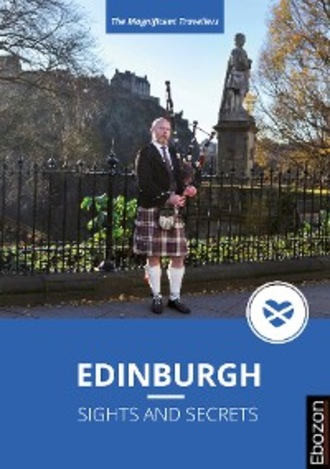
Edinburgh – Sights and Secrets

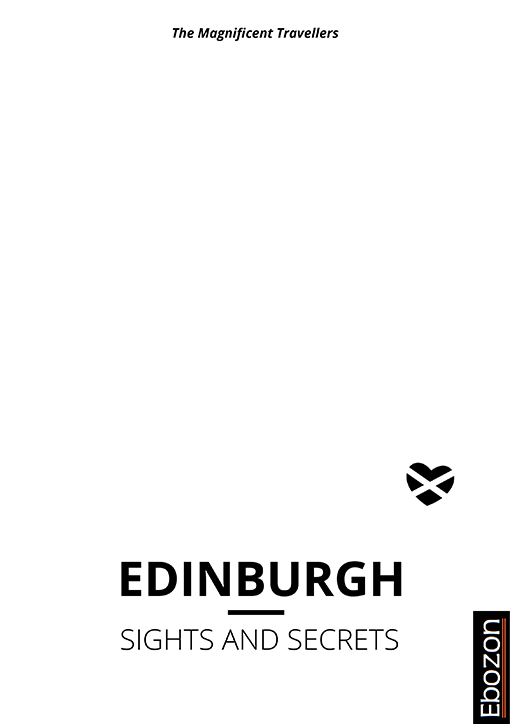
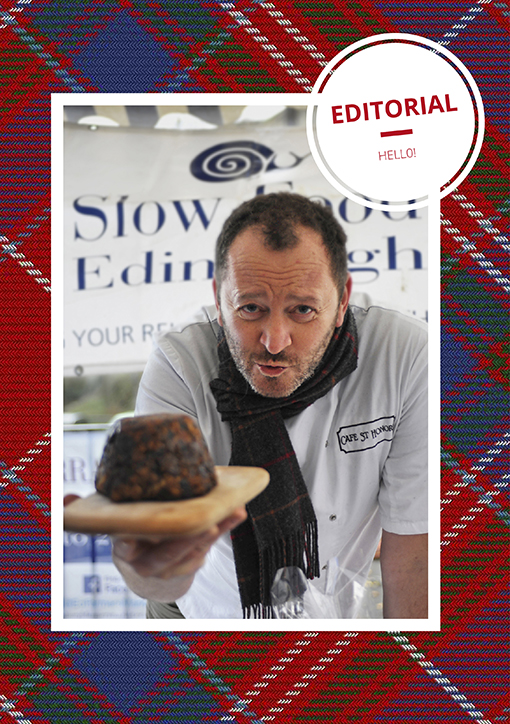
edinburgh – the beauty in the north
Edinburgh. Nestled in an idyllic natural landscape between the shores of the Firth of Forth and the volcanic hills that are the gateway to the Scottish Highlands. A small capital, on the fringe of Europe – but so much more, and with so much more to discover.
Climb King Arthur’s Seat for a view of the rugged scenery that surrounds the city. Discover buildings, streets and areas with histories richer and deeper than Edinburgh’s emblematic castle. When the weather turns, take shelter in breathtaking museums and galleries like the National Museum of Scotland or the little Writers’ Museum – many of them absolutely free.
Partake of a pub experience like no other, or join a traditional Ceilidh dance evening. Around every corner, the charm of small shops, cafes and restaurants invite you to abide and wander. No doubt you’ll want to join in a malt whisky tasting – or perhaps you’ll even pluck up the courage to try Scotland’s famed and infamous national dish, Haggis?
But for all this delightful city’s charms, don’t miss your chance to venture out and discover the treasures that wait just outside it. Enjoy the gentle sea breeze in Portobello – the Brighton of the North. Lose yourself in the mystic atmosphere of Rosslyn Chapel, immortalized in Dan Brown’s The Da Vinci Code.
Enjoy discovering!

the scottish parliament – green from the roof to the loo
text sabrina wendling, photo werner gritzbach
It’s a sparkling gem amid rolling wildflower meadows, ponds, and woods of wild cherry and lime trees. Viewed from above, the Scottish Parliament building even looks like the leaves of a tree. That’s by design – nature is the recurring theme in its architecture, and the building itself merges with the landscape. Or, as the architect Enric Miralles puts it, the parliament “grows out of the land.”
Even inside the building, you will find the shape of leaves almost everywhere. In the garden lobby, you stroll under a forest canopy of leaves – in glass and steel – adorning the roof.
But there’s also real nature inside the parliament: gutters at the windows bring rainwater down to the lavatories – where it is used to flush the toilets. A building green from the roof to the loo.
Even in the debating chamber, where the 129 representatives discuss issues such as agriculture, environment and health, you will feel close to nature. The representatives have a spectacular view to the hills, which the visitors can also enjoy. But do plan to visit early – the Scottish Parliament is a hot spot for both tourists and locals. In fact, often there are more visitors than representatives in the chamber.
Scottish Parliament, Edinburgh EH99 1SP.
Tickets: Tickets for First Minister’s Question Time can only be booked by telephone on 0131 348 5200 or freephone 0800 092 7600. Textphone users can use 0800 092 7100. Tickets for other debates can be booked online: www.scottish.parliament.uk
Guided tours are free. There are also theme tours on art, history and literature.
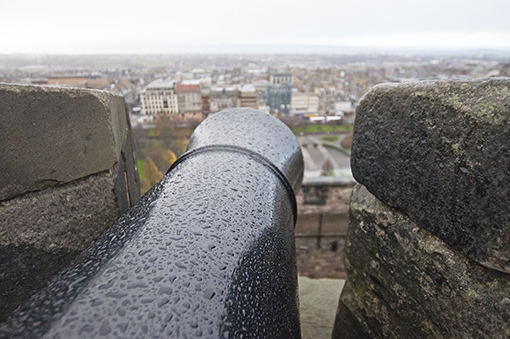
edinburgh castle – symbol of the city
text and photo michaela schneider
Steeped in history, Edinburgh Castle dominates the Old Town skyline, brooding atop its great volcanic rock. It is the very symbol of the capital and the turbulent history of Scotland itself: kings were born here, prisoners imprisoned, guests assassinated and treasures hidden. Visitors passing through its granite gates can stand alongside the heavy guns here to enjoy panoramic views of the city. Entering the castle, visitors are greeted by the twin statues of freedom fighters William Wallace and King Robert the Bruce.
The first castle was built here in the Middle Ages, but apart from St. Margaret’s Chapel and one section of David’s Tower, little remains from this era. Close by lies the heart of the castle, Crown Square with the Royal Palace, the Great Hall and the Scottish National War Memorial. Not to be missed is the museum, where visitors will find the Honours of Scotland. The beautiful crown, sceptre and sword are the oldest crown jewels on the British Islands, and the legendary Stone of Destiny has been part of the coronation ceremonies of the Kings of Scotland, England and the United Kingdom for more than a thousand years. But the modern and descriptive exhibition of the history of the Scottish Kings also make a visit to the museum more than worthwhile: where else can you meet the historic monarchs of Scotland, like Robert the Bruce and Mary Stuart?
While you’re here, also look into the royal apartments – today used for official receptions. For those interested in military history, there are no less than three military museums on the castle grounds, and the National War Memorial, bearing the names of every fallen Scottish soldier from World War I, is a place for silence and reflection.
Another of the castle’s attraction is the firing of the gun – every day (except Sunday) at one o’clock. In the 19th century, the people of Edinburgh set their clocks by the shot, and sailors on the Forth would calibrate their chronometers by it. But why at one o’clock and not at noon? Conventional wisdom has it that it’s down to the Scots’ legendary frugality: why fire twelve cannonballs, when one will do?
The best approach is to discover the castle on a guided tour or with an audio guide. Budget at least three hours.
Tip: If you love animals, take a walk to the dog cemetery - for over 150 years, the final resting place of the regiment’s mascots and officers’ dogs.
Castlehill, Edinburgh EH1 2NG.
1 Apr - 30 Sep 9.30am - 6pm, 1 Oct - 31 Mar 9.30am - 5pm.
£16, audio guide £3.
www.edinburghcastle.gov.uk
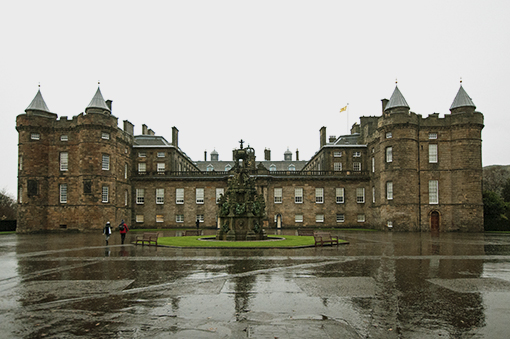
holyroodhouse – the queen’s official residence
text and photo michaela schneider
Holyroodhouse is more than an imposing historical site. Rebuilt in neoclassical style, the palace is one of the official residences of the royal family today. An audio guide is available in several languages to give visitors much of the historical background, but you will also hear voices from the past, like the ancient castle stewards, conveying their first-hand knowledge of the place. Visitors are welcomed by Prince Charles’s voice.
Following the traditional route of procession, visitors discover each room more magnificent than the last. You pass heavy Gobelin tapestries, richly ornamented stucco ceilings, and elegant Victorian furnishings until reaching the jewel of the route, the King’s Bed Chamber, a room where once only the most privileged guests were permitted.
A narrow spiral staircase leads to the oldest part of the castle. Here Mary Stuart, Queen of Scots, was forced to watch the assassination of her secretary and close confidant David Rizzio - a thrilling story of jealousy, conspiracy and political intrigue.
The tour finishes at the forbidding yet enchanting ruins of Holyrood Abbey, the place that inspired Felix Mendelssohn’s Scottish Symphony. In summertime, visitors can also walk through the Royal Gardens.
Tip: The Queen’s Gallery next to Holyroodhouse hosts a changing programme of exhibitions from the Royal Collection.
Palace of Holyroodhouse, Canongate, The Royal Mile, Edinburgh EH8 8DX.
£11. Audio guide and guided tours for free.
Nov - Mar 9.30am - 4.30pm. Apr - Oct 9.30am - 6pm.
www.royalcollection.org.uk
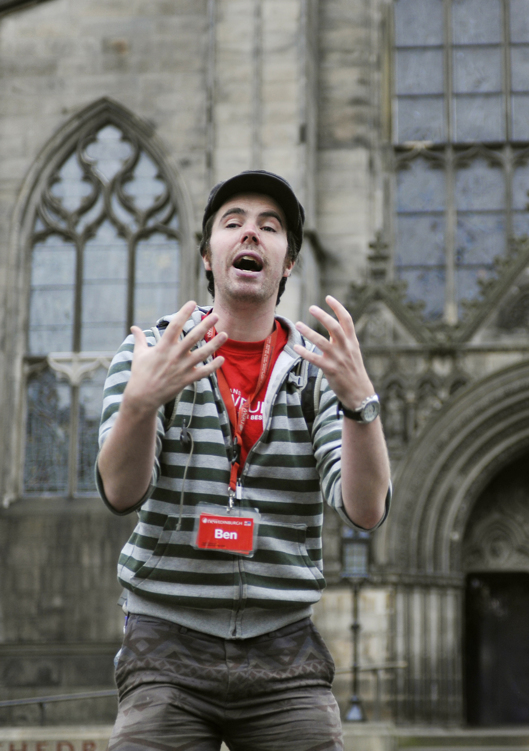
discover edinburgh – take a guided tour
text and photo gerald biebersdorf
As a first-time Edinburgh visitor, a good way to get your bearings and a great experience all around is a free guided tour. Our guide, Ben, is truly passionate about his city, performs like a stage actor and tells fascinating stories. As you progress from the starting point at the Tron Kirk on High Street, you will hear Ben’s opinion of the film Braveheart, learn the history of St. Giles Church as you pass it on the Royal Mile, and visit Edinburgh’s oldest cemetery, Greyfriars Kirkyard, where you will find the graves of many famous Scots like architect James Craig, who laid out the New Town, and Duncan Ban MacIntyre, the most famous Gaelic poet. Ben will also probably tell you about when a tourist asked him where he could find Sean Connery’s grave. “Ahem! – Sean Connery is still very much alive.”
But there’s another story of this cemetery, one that will touch your heart: just outside the entrance, you see a monument to a dog named Bobby. The story goes that when his master, old sergeant John Gray, died, Bobby came here every day for 14 years, waiting for his master to come back. Locals brought him food and water and were so touched by his loyalty that when Bobby died, in 1872, they placed this life-size bronze statue of him here.
Tron Kirk, High Street, Edinburgh.
Meeting point in front of the Starbucks Coffee.
Mon - Sun 11am, 1pm, 3pm.
www.newedinburghtours.com
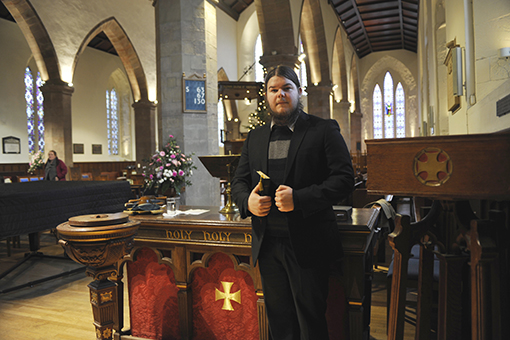
notes from the parish – a visit to greyfriars kirk gaelic service
text lydia ranke, photo gerald biebersdorf
There are over 60 churches in Edinburgh, but only one where you can experience a service in Gaelic. Every Sunday at 12.30 pm, Greyfriars Kirk in the Old Town holds a Gaelic Service for its small but loyal congregation. Usually, attendance is between 10 and 20 people. So visitors are heartily welcome!
As a non-Gaelic-speaker, the service is a great opportunity to get a sense of this traditional, historic, and endangered language. And if you’re very lucky, you might even get to listen to a Gaelic song sung by a native Gaelic speaker, like 87-year-old Roddy Macdonald from the Isle of Skye. The basic content of the Service is also kindly translated for the visitor.
After the service, the visitor may stay and chat, have a tea or a coffee, and enjoy the charming company of the members of the congregation. And after all that, if you’re still not ready to move on, the famous kirkyard surrounding the church, dating back to the 16th century, is well worth a stroll around.
1 Greyfriars, Edinburgh EH1 2QQ.
Services every Sunday: Main Service 11am, Gaelic Service 12.30pm.
Duration: approx. 1 hour.
Tip: Bring some change for the collection.
www.greyfriarskirk.com
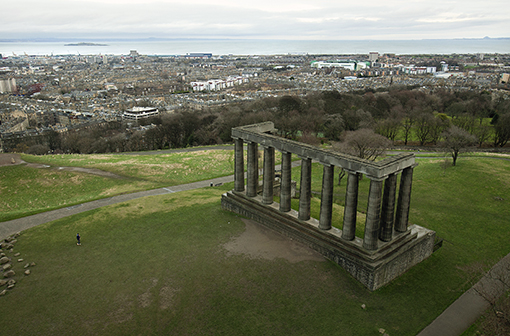
calton hill – a photographer’s delight
text and photo werner gritzbach
The eastern end of Princes Street rises towards Calton Hill, created by volcanic action 340 million years ago.
In 1724 the city of Edinburgh bought Calton Hill and turned it into one of Britain’s first public parks. There are a number of buildings and monuments here dating from 1760 to 1820, a period of great artistic, literary and scientific advancement known as the “Scottish Enlightenment”.
As you enter the hill from Waterloo Place, you pass Rock House, which was home to pioneering photographer David Octavius Hill.
Further up you come to the lighthouse-like Nelson’s Monument. Climb the 143 stairs inside for one of the most beautiful views over the city.
The National Monument, built by famous Scottish architect William Henry Playfair, looks like half a Greek temple with 12 Doric columns, but is not nearly so old as it looks: it was built to commemorate the victims of the Napoleonic Wars. Does it seem half-finished? The story goes that the money ran out during the construction works.
A walk round the hill is worth it for terrific views across Edinburgh to Arthur’s Seat and the entire coastline of the Firth of Forth.
Tip: On the other side of Waterloo Place you can visit a beautiful old cemetery, the “Old Calton Burying Ground”, where you will find the graves of many famous Edinburghers like David Hume, painter David Allen, mathematician John Playfair and actor Charles MacKay.
Calton Hill, Waterloo Place, Edinburgh EH7 5AA.
Nelson’s Monument:
1 Apr - 30 Sep: Mon - Sat 10am - 7pm, Sunday 12 pm - 5pm.
1 Oct - 31 Mar: Mon - Sat 10am - 3pm, Sunday 12pm - 3pm.
£4.
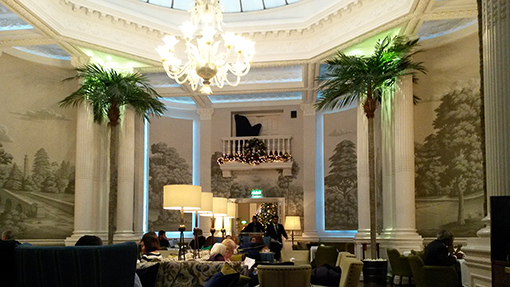
the balmoral hotel – eat the luxury
text and photo sabrina wendling
The Balmoral Hotel on Princes Street may be a very old lady, but still attractive at over a hundred years old. With its opulent Edwardian architecture and outstanding clock tower, you might think it was once a castle, but in fact it was built as a station hotel to serve Waverley Station just below it.
The Queen Mother frequently had lamb for lunch in the hotel restaurant; other famous guests have included Sophia Loren, Elizabeth Taylor and Paul McCartney.
If you want to feel like a celebrity for a day, treat yourself to the award-winning afternoon tea. It’s served in Palm Court, a room bursting with the opulence of the British Empire – large glass dome, velvet settees and tall palms stretching up to the ceiling. Tea is served in a silver pot, and the food comes on a three-tier cake stand. A little snowman made of lemon cream here, an orange madeleine cookie there, and freshly baked scones everywhere. The savoury course includes smoked salmon on bread, chicken curry in puff pastry and cheese crackers. And then, even more cake. You’ll never manage it all! But never fear, you’ll also be given a small box for taking away. Expensive? Yes, but it’s an extraordinary dining experience in a unique setting.
Tip: You can order as much tea or coffee as you like along with your afternoon tea. If you don’t like the flavour you’ve chosen, just ask for another one.
1 Princes Street (next to Waverley Station), Edinburgh EH2 2EQ.
Afternoon tea costs £29 and is served between 12 and 5.30pm.
www.roccofortehotels.com
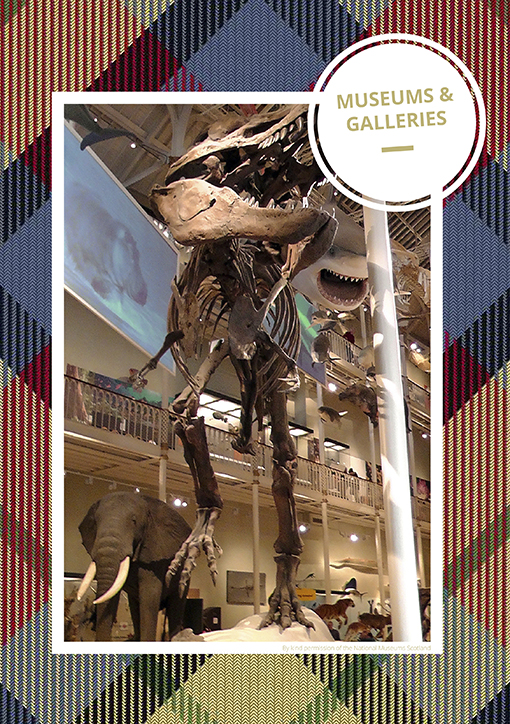
national museum of scotland – following historical traces
text and photo sascha ihns
The National Museum of Scotland opened its doors in 1866 as the Edinburgh Museum of Science and Art. Today it is Britain’s largest museum outside of London, with more than 20,000 items on exhibit and drawing up to two million visitors a year on average. In 2011 the original Victorian-style Royal Museum was refurbished and integrated into the postmodern National Museum building (inaugurated in 1998) with its distinctive castle turret at the front.
Visitors begin in the vast entrance hall of the former Royal Museum, bathed in natural light and with a dazzling (even confusing) array of options for starting their tour. There are a number of galleries to choose from, like Grand Gallery, Window on the World, Art and Design or Discoveries. One of the most impressive exhibitions (and a favourite among younger visitors) is the Natural History Gallery, where visitors can gaze at several real dinosaur skeletons alongside modern animals (mounted) as well as fossils and geological findings explaining the development of our planet up to the present. Other exhibitions like World Cultures offer items and explanations about different indigenous people and present archaeological findings like weapons and coins from ancient Egypt and the Islamic world. In the Science and Technology gallery, visitors can get to know numerous Scottish inventions and also come face-to-face with a very famous Scot – Dolly the Sheep, who found her final resting place here, stuffed and mounted.
Afterwards, take a break at the museum’s café on Level 3 of the entrance hall before strolling on to the new part of the National Museum and it’s further 10,000 items. Here the visitor can trace the path of Scottish history, beginning at the lowest level with prehistory and then progressing to the early medieval period with its ecclesiastical history and religious wars, towards the industrial revolution and its impact on modern Scottish life. Highlights like the “Maiden”, an early Scottish version of a Guillotine, are explained interactively via touchscreens, while other exhibits like the complete steam locomotive and weaving loom are impressive enough without further explanation.
Tip: The upmarket Tower Restaurant is a lovely spot with a fantastic view above the roofs of Edinburgh. Just off the restaurant is a rooftop panorama terrace open to anyone, even if you’re just stopping by for the view.
Chambers Street, Edinburgh EH1 1JF.
Mon - Sun 10am - 5pm. Admission free.
www.nms.ac.uk
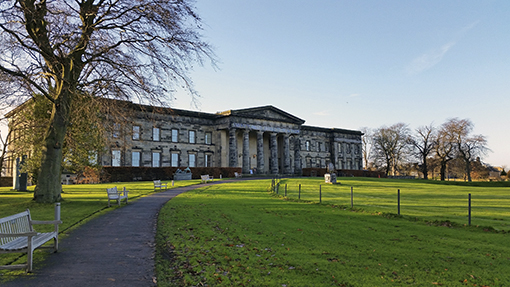
scottish national gallery of modern art – a colourful place
text and photo melanie dworaczek
Surrounded by scenic parkland on the outskirts of the city, just a 20-minute walk from the city centre, the delights of the Gallery of Modern Art await. Escape the beehive of activity that is the city to unwind with the perfect companion – art.
Two exhibitions, 30 displays and whole worlds of artists across different eras, with something for everyone, from the casual tourist to the art connoisseur. Opposite Modern Art Two is the gallery where you’ll find iconic works by Monet, Van Gogh, Raphael and Titian, Canova’s spectacular sculpture The Three Graces, and of course a wealth of Scottish art. In addition to the permanent exhibition, the gallery hosts frequent world-class temporary exhibits – Matisse and Picasso have both been recent highlights. Of course, we cannot neglect to mention the important permanent collection of international works from the postwar period, or the world’s most important and comprehensive collection of modern Scottish art. The postwar collection includes works by Francis Bacon, David Hockney, Andy Warhol and Lucian Freud; modern artists represented include Antony Gormley, Gilbert & George, Damien Hirst and Tracey Emin. But don’t just come for the art; the gallery’s café is sure to please the whole family: bright atmosphere, culinary delights, stylish presentation. Fresh salads, healthy menus, tea, coffee, fresh baked cookies and cakes - a delicious selection any way you slice it, in an ambiance that begs you to lean back and enjoy the moment.
Fifteen minutes’ walk from Princes Street, or an easy jaunt on coach line 13. Admission is free, although selected temporary exhibitions may be subject to charge. The Scottish National Gallery of Modern Art is also one of the major venues for the Edinburgh Festival in August.
Tip: Vegetarian options (at least ∫ main courses), children’s portions, children’s highchairs, wheelchair access, outdoor tables, free Wi-Fi.
75 Belford Road, Edinburgh EH43DR.
Open daily, 10am - 5pm (6pm in August only).
Closed 25th and 26th Dec and open on 1st Jan from 12pm.
Admission is free. Special exhibitions may be subject to charge.
www.nationalgalleries.org
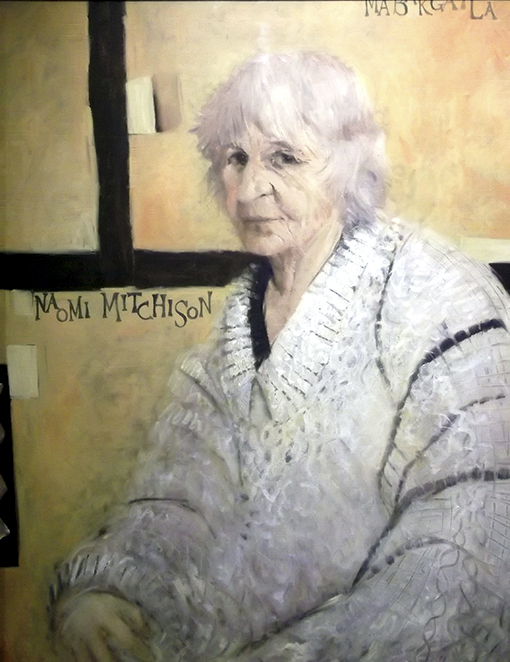
scottish national portrait gallery – meet sir walter scott and colin montgomerie
text and photo susanne schramm
This impressive neo-gothic, red sandstone building on Queen Street built from 1885-1890 is highly recommended for anyone interested in architecture.
The building itself is imposing enough from afar, but a closer look reveals the exquisite details – ornate friezes, detailed murals, and sophisticated, sculptural embellishments. Even if you’re not looking to see the portraits, you’ll want to make a stop here.
Inside you’ll find a comprehensive collection of portraits of historical figures from the 16th century to the present – figures who shaped Scotland, by the leading names of Scottish art. Like Sir Walter Scott by Alexander Naemyth, Robert Burns by Henry Raeburn or more contemporary pioneers in arts, sports and science, such as Colin Montgomerie by Iain Faulkner.
The Scottish National Photography Collection on the 1st Floor presents temporary exhibitions, as well as popular works by Robert Adamson and David Octavius Hill. With its annual BP Portrait Award event, the Gallery also brings together an inspiring exhibition that encourages artists from around the world to develop the theme of portraiture in their work.
Between the seventeen galleries with both temporary and permanent exhibitions, and the Victorian library, there will always be something interesting and new to discover.
In the Great Hall, the gallery hosts free events like concerts and talks, so check the programme to see what’s on next.
Tip: The Portrait Cafe serves fresh deli sandwiches, soups, mains, and the best buttery scones in town.
1 Queen Street, Edinburgh EH21JD.
Open daily 10am - 5pm (6pm in August only), Thursdays until 7pm.
Admission is free (special exhibitions subject to charge).
www.nationalgalleries.org

sir walter’s locks – the writers’ museum
text and photo andrea weil
You might know the three classic Scots novels Treasure Island, Ivanhoe and Scots Wha Hae. But did you know there’s a museum dedicated to their authors? Many discover it because the Lady Stair’s House, built in 1622, catches the eye with its stone tower and high windows. Half of the main room is occupied by the museum’s shop, which sells exquisite hardcover editions of a wide range of authors. If you just want to sit down for a good read beyond the glow of the shadow-casting chandeliers on the red walls, there’s a small library available in the gallery. In the exhibition, timelines trace the authors’ personal stories against the historical background of their time. How did farmer’s son Robert Burns become such an influential poet? Why did Walter Scott publish his first novel, Waverley, anonymously? Why did Robert Louis Stevenson spend his later years in Samoa, where the ink was, as he described it, “dreadful”? You might find, though, that the museum doesn’t reveal the same level of depth about each of the three. Some visitors may be thrilled to see a lock of Scott’s hair, but it hardly adds the kind of perspective on the author that the photos of Stevenson’s journeys do.

